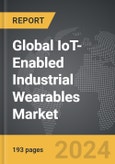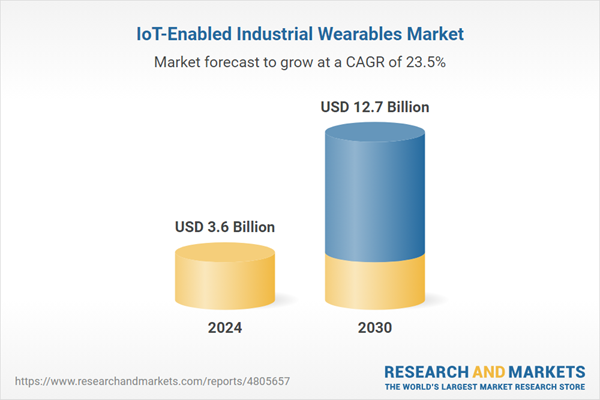The global market for IoT-Enabled Industrial Wearables was valued at USD 3.6 Billion in 2024 and is projected to reach USD 12.7 Billion by 2030, growing at a CAGR of 23.5% from 2024 to 2030. This comprehensive report provides an in-depth analysis of market trends, drivers, and forecasts, helping you make informed business decisions.
Global Industrial Wearables Market - Key Trends & Drivers Summarized
How Are Industrial Wearables Transforming Workplace Safety and Productivity?
Industrial wearables are revolutionizing the way safety and productivity are managed across various sectors, including manufacturing, construction, and logistics. These devices, which include smart helmets, glasses, gloves, and exoskeletons, are designed to monitor workers' health, enhance communication, and provide real-time data to improve operational efficiency. The integration of sensors, GPS, and IoT technologies into wearable devices allows for continuous monitoring of environmental conditions, detection of potential hazards, and instant alerts to both workers and supervisors. This real-time data capability not only helps in preventing accidents and ensuring compliance with safety regulations but also enhances workforce productivity by reducing downtime and streamlining processes. As a result, industrial wearables are becoming indispensable tools for companies looking to optimize their operations while prioritizing employee safety.Why Are Technological Advancements Pushing the Boundaries of Industrial Wearables?
Technological advancements are significantly pushing the boundaries of what industrial wearables can achieve, making them more sophisticated and versatile. The integration of artificial intelligence (AI) and machine learning (ML) algorithms into these devices enables predictive analytics, allowing companies to foresee equipment failures, monitor workers' fatigue levels, and even predict potential safety incidents before they occur. Moreover, advancements in battery technology and wireless communication have led to the development of wearables with longer battery life and better connectivity, ensuring that devices remain operational throughout the workday. Augmented reality (AR) is another key innovation, particularly in smart glasses, where it is used to overlay digital information onto the physical world, assisting workers with complex tasks, reducing the need for on-site training, and improving the accuracy of work performed. These technological leaps are transforming industrial wearables from simple monitoring tools into powerful devices that enhance decision-making and operational efficiency.What Challenges and Opportunities Are Shaping the Industrial Wearables Market?
While the industrial wearables market is poised for significant growth, it is not without its challenges. One of the primary concerns is the cost of implementing these technologies, particularly for small and medium-sized enterprises (SMEs) that may struggle with the initial investment. Additionally, there are issues related to data security and privacy, as the continuous monitoring of workers generates vast amounts of personal data that must be protected against breaches. However, these challenges also present opportunities for innovation and market differentiation. Companies that can offer cost-effective solutions, along with robust data security measures, stand to gain a competitive edge. Furthermore, the increasing adoption of Industry 4.0 practices, which emphasize automation and data exchange in manufacturing technologies, is creating a fertile ground for the growth of industrial wearables. The ability to seamlessly integrate wearables with other IoT devices and platforms is becoming a key selling point for manufacturers looking to enhance their offerings.What Factors Are Driving Growth in the Industrial Wearables Market?
The growth in the industrial wearables market is driven by several factors, including the increasing focus on workplace safety, the rising adoption of Industry 4.0, and advancements in wearable technology. The need to comply with stringent safety regulations and the desire to minimize workplace accidents are compelling companies to invest in wearables that can monitor environmental conditions and worker health in real-time. Additionally, the push towards digital transformation in industries is accelerating the adoption of wearables as part of broader IoT ecosystems, where data from various sources is integrated to optimize operations. Technological advancements, such as AI-driven predictive analytics, AR-enhanced smart glasses, and improved connectivity, are also propelling market growth by offering new functionalities that enhance the value proposition of industrial wearables. Furthermore, the growing awareness of the benefits of wearables in improving productivity and reducing operational costs is driving demand across various sectors, making industrial wearables a key component of the future workplace.Report Scope
The report analyzes the IoT-Enabled Industrial Wearables market, presented in terms of market value (USD Thousand). The analysis covers the key segments and geographic regions outlined below.Segments
Product (Hand-Worn Wearables, Head-Mounted Wearables, Smart Eyewear).Geographic Regions/Countries
World; United States; Canada; Japan; China; Europe (France; Germany; Italy; United Kingdom; and Rest of Europe); Asia-Pacific; Rest of World.Key Insights:
- Market Growth: Understand the significant growth trajectory of the Hand-Worn Wearables segment, which is expected to reach $6.6 Billion by 2030 with a CAGR of a 24.1%. The Head-Mounted Wearables segment is also set to grow at 24.6% CAGR over the analysis period.
- Regional Analysis: Gain insights into the U.S. market, valued at $1 Billion in 2024, and China, forecasted to grow at an impressive 22.6% CAGR to reach $1.9 Billion by 2030. Discover growth trends in other key regions, including Japan, Canada, Germany, and the Asia-Pacific.
Report Features:
- Comprehensive Market Data: Independent analysis of annual sales and market forecasts in USD from 2024 to 2030.
- In-Depth Regional Analysis: Detailed insights into key markets, including the U.S., China, Japan, Canada, Europe, Asia-Pacific, Latin America, Middle East, and Africa.
- Company Profiles: Coverage of major players such as Alphabet, Inc., DAQRI, Fujitsu Ltd., Kopin Corporation, Seiko Epson Corporation and more.
- Complimentary Updates: Receive free report updates for one year to keep you informed of the latest market developments.
Why You Should Buy This Report:
- Detailed Market Analysis: Access a thorough analysis of the Global IoT-Enabled Industrial Wearables Market, covering all major geographic regions and market segments.
- Competitive Insights: Get an overview of the competitive landscape, including the market presence of major players across different geographies.
- Future Trends and Drivers: Understand the key trends and drivers shaping the future of the Global IoT-Enabled Industrial Wearables Market.
- Actionable Insights: Benefit from actionable insights that can help you identify new revenue opportunities and make strategic business decisions.
Key Questions Answered:
- How is the Global IoT-Enabled Industrial Wearables Market expected to evolve by 2030?
- What are the main drivers and restraints affecting the market?
- Which market segments will grow the most over the forecast period?
- How will market shares for different regions and segments change by 2030?
- Who are the leading players in the market, and what are their prospects?
Some of the 44 major companies featured in this IoT-Enabled Industrial Wearables market report include:
- Alphabet, Inc.
- DAQRI
- Fujitsu Ltd.
- Kopin Corporation
- Seiko Epson Corporation
- SmartCap Technologies Pty Ltd
- Vuzix Corporation
Table of Contents
I. METHODOLOGYII. EXECUTIVE SUMMARY2. FOCUS ON SELECT PLAYERSIII. MARKET ANALYSISIV. COMPETITION
1. MARKET OVERVIEW
3. MARKET TRENDS & DRIVERS
4. GLOBAL MARKET PERSPECTIVE
UNITED STATES
CANADA
JAPAN
CHINA
EUROPE
FRANCE
GERMANY
ITALY
UNITED KINGDOM
REST OF EUROPE
ASIA-PACIFIC
REST OF WORLD
Companies Mentioned (Partial List)
A selection of companies mentioned in this report includes, but is not limited to:
- Alphabet, Inc.
- DAQRI
- Fujitsu Ltd.
- Kopin Corporation
- Seiko Epson Corporation
- SmartCap Technologies Pty Ltd
- Vuzix Corporation
Table Information
| Report Attribute | Details |
|---|---|
| No. of Pages | 193 |
| Published | April 2025 |
| Forecast Period | 2024 - 2030 |
| Estimated Market Value ( USD | $ 3.6 Billion |
| Forecasted Market Value ( USD | $ 12.7 Billion |
| Compound Annual Growth Rate | 23.5% |
| Regions Covered | Global |









